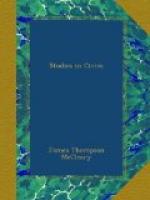Later: This system is now used in several states.
WHY AND HOW NOMINATIONS ARE MADE.
A political party may be defined as a number of persons holding similar views in relation to one or more questions of public policy, and who through unity of action seek to have these views prevail.
The great instrument for securing unity is the convention. It may be a mass meeting, or, as is more usual among the large and well-organized parties, a convention of delegates. In either case it is, be it remembered, not a part of the elective machinery designed by the legislature, but a political device to increase the chances of victory through unity of purpose and action.
Party organization consists of “committees”—town, village, city-ward, county, state, and national. The local committees are chosen by the resident partisans; the county committees by the county conventions; the state committees by state conventions; and the national committee, consisting usually of one member from each state, by the delegates of the respective states to the national convention. Each committee chooses its own chairman and secretary. Besides those mentioned, there are district committees, such as congressional-district committees, senate-district committees, etc., whose members are appointed in a manner similar to that given above. The term of a member is, as might be expected, from the close of one regular convention to the close of the succeeding one. Thus a town committeeman’s term is one year, while that of a national committeeman is four years.
The mode of nominating a candidate for the presidency of the United States will illustrate the way of making nominations in general.
1. By long-established practice, each state is entitled to twice as many delegates to the national convention as the number of its presidential electors, and each territory to two delegates. Thus, Minnesota being entitled to nine electors, may send eighteen delegates: and New York, having thirty-six electors, is entitled to seventy-two delegates. Each delegate has an alternate, who acts in the delegate’s absence.
2. Though the popular election does not take place until November, the national conventions are usually held in June or July. This is probably to allow plenty of time for the campaign.
3. To allow the machinery time to grind out the delegates, the national committee, having early determined upon the time and place for holding the convention, issues its “call” some months in advance, say in February or March. This is published in the newspapers throughout the country.
4. The next step in the process is the issuance of calls by the several state committees. These are issued as soon as practicable after that of the national committee, and usually appoint the state convention for the latter part of May.
5. In some states all of the delegates to the national convention are chosen by the state convention. But the number of states is increasing, and properly so, in which each congressional district chooses its own two delegates, leaving only the four “delegates at large” to be chosen by the state convention. In these states, the next step is the call of the district committee for a convention slightly antedating that of the state.




